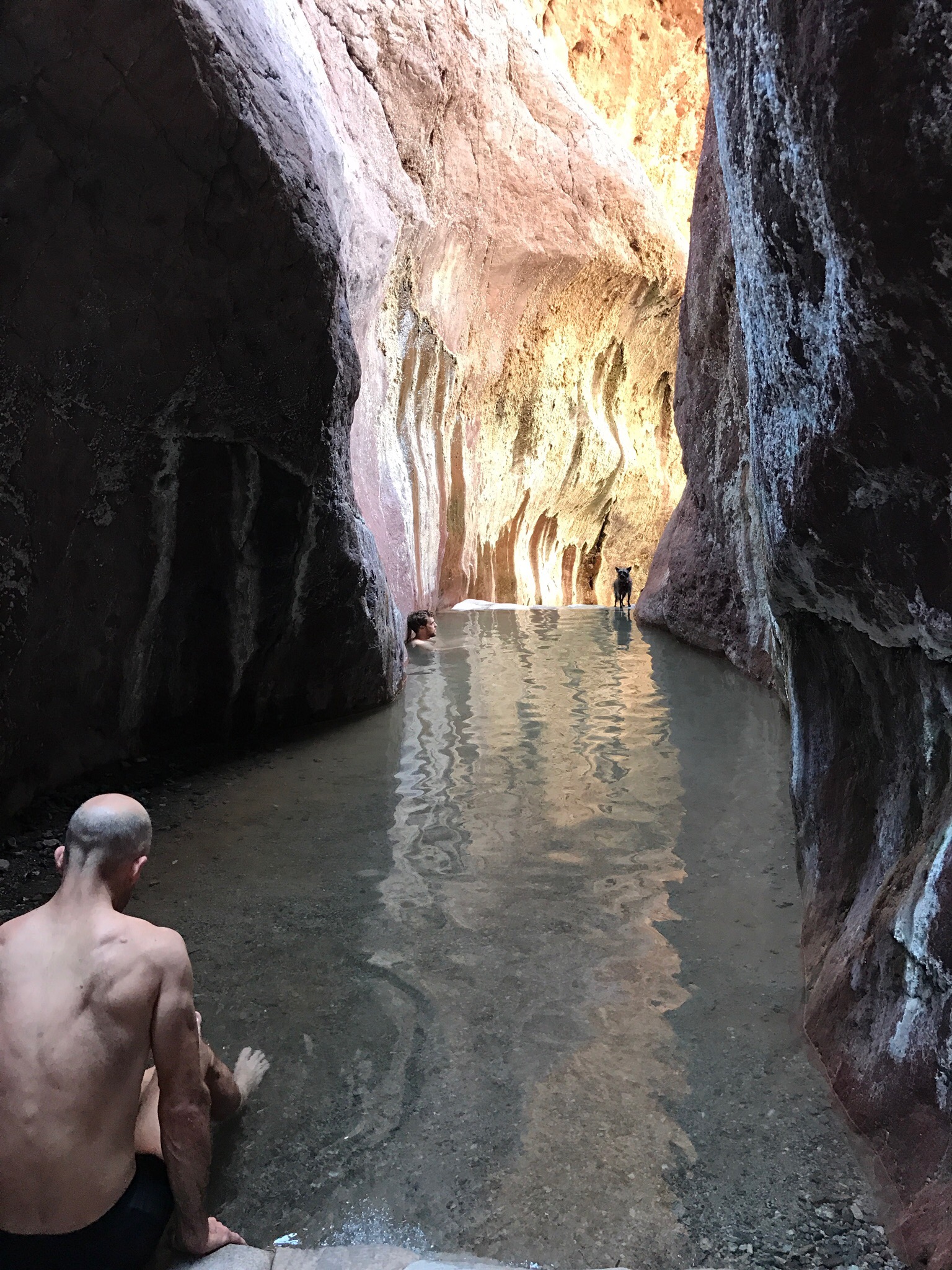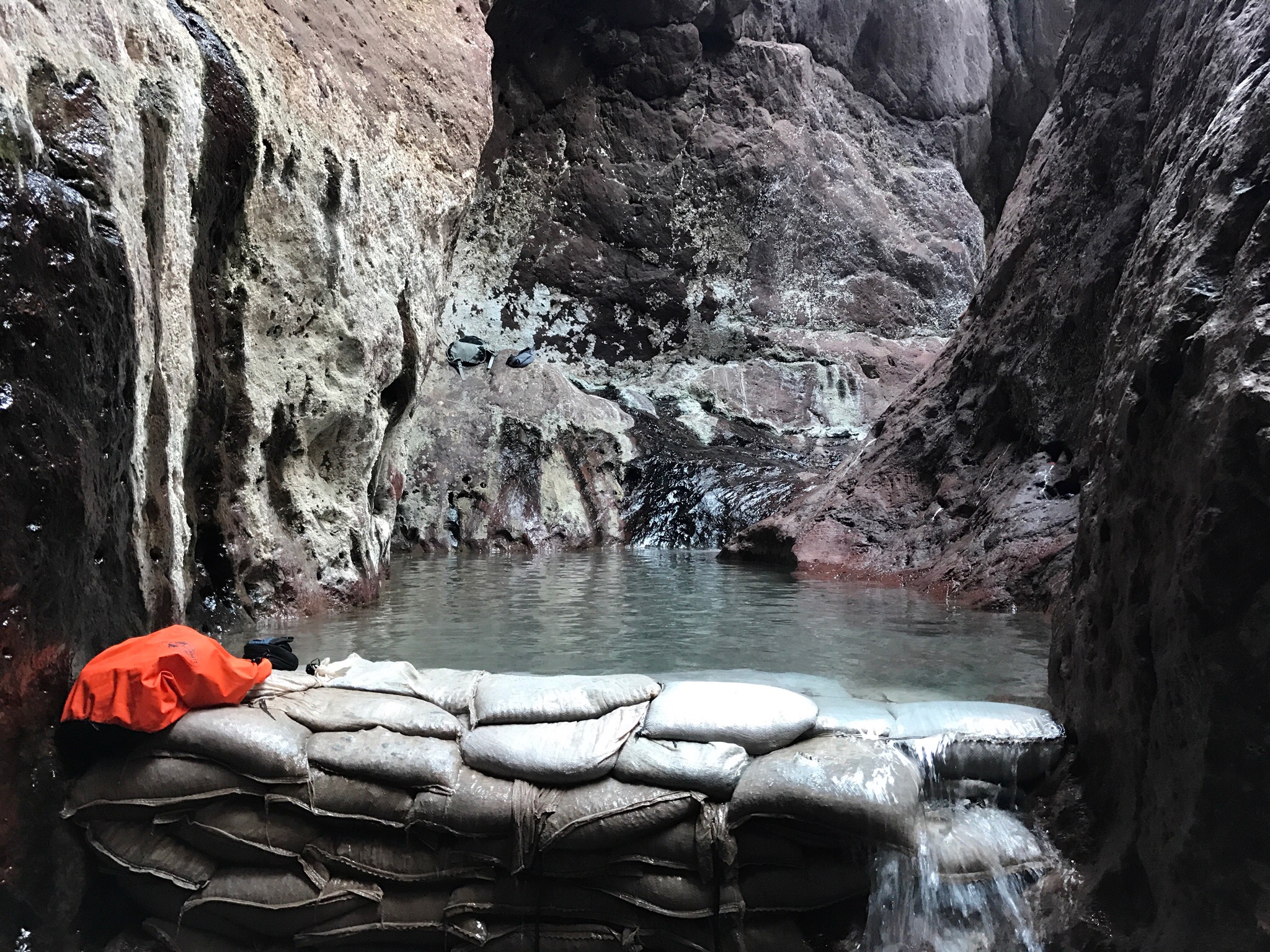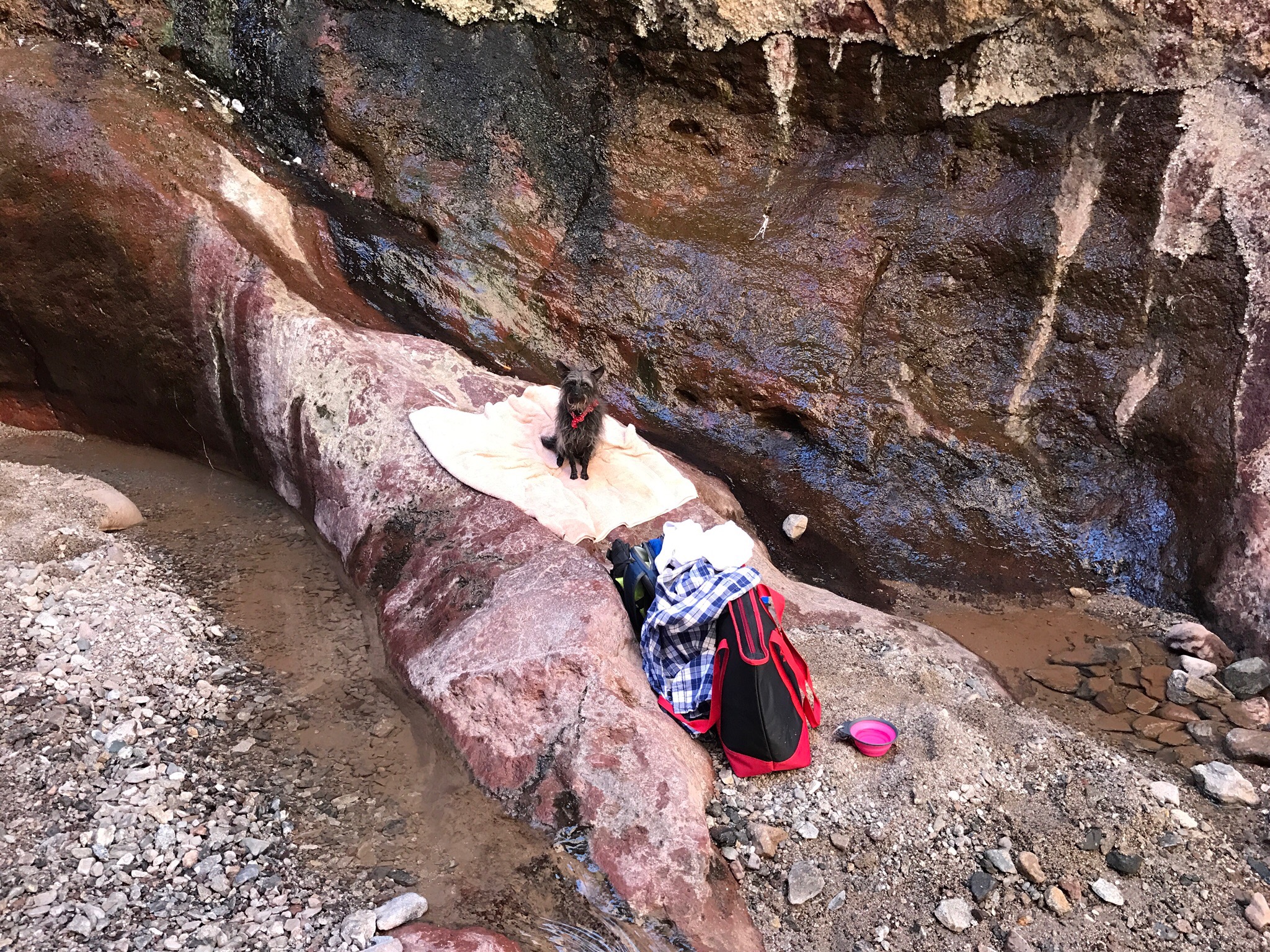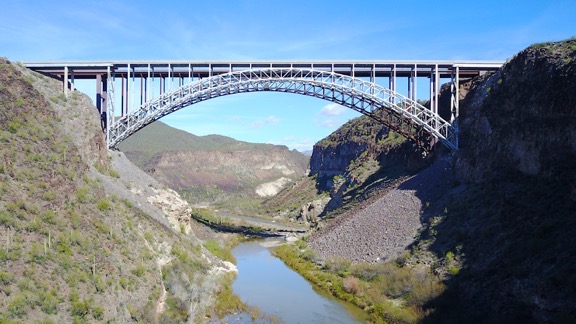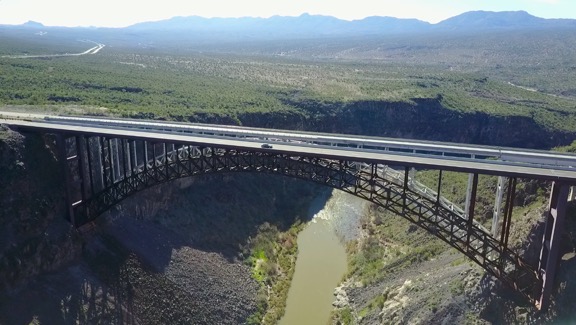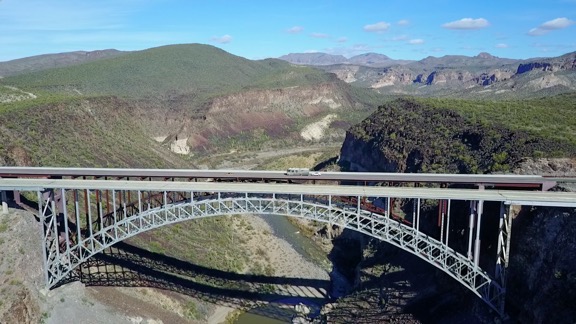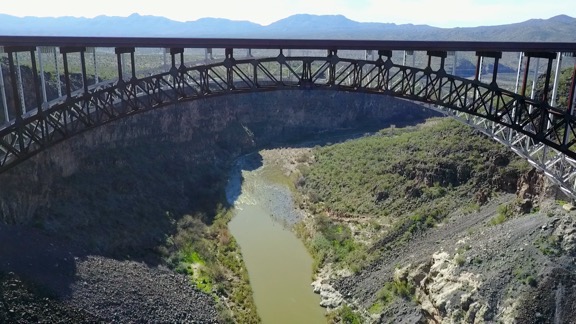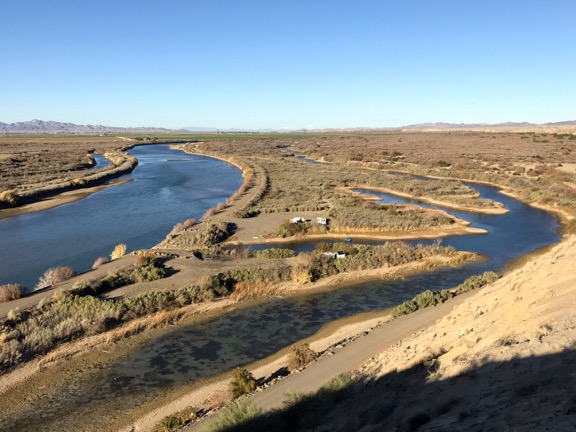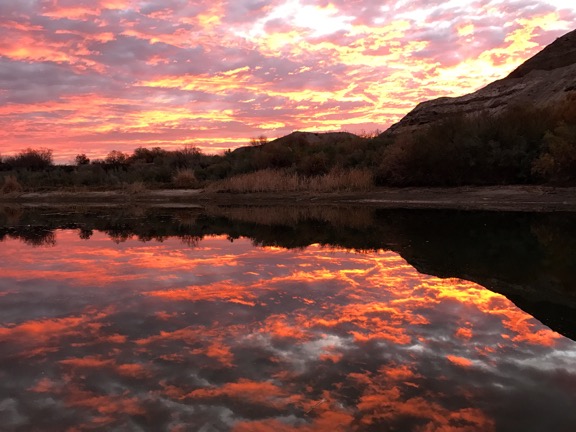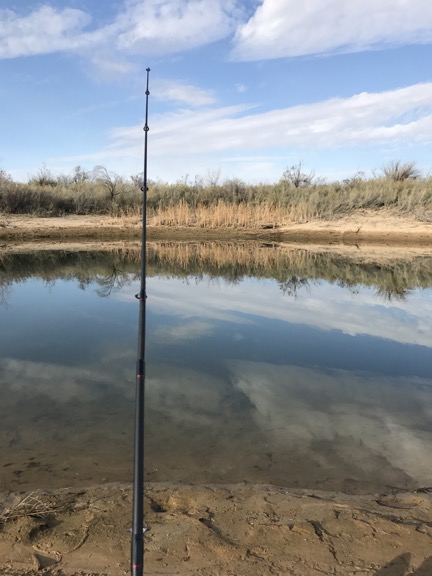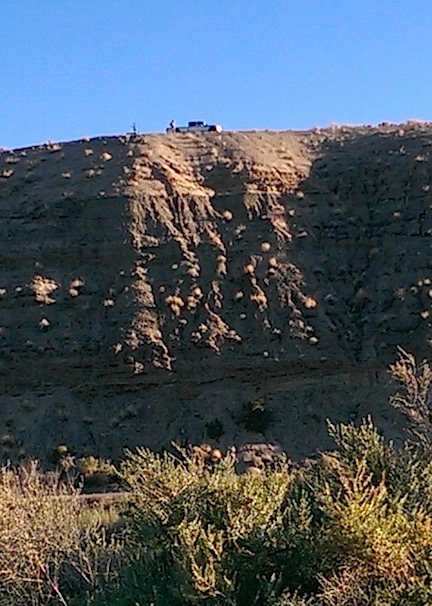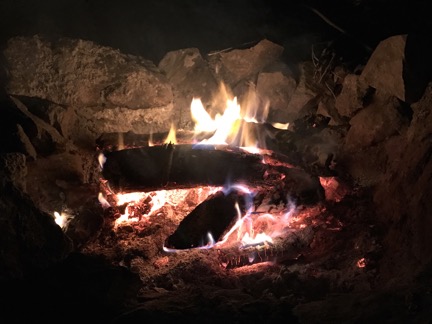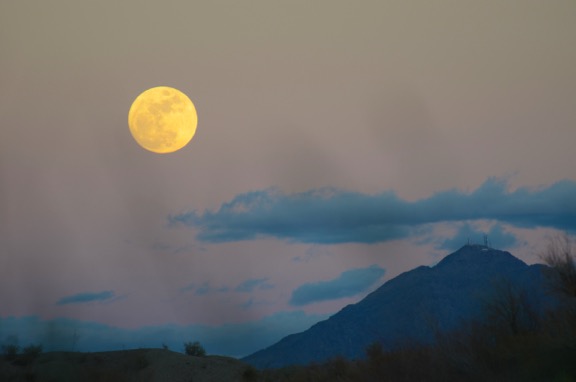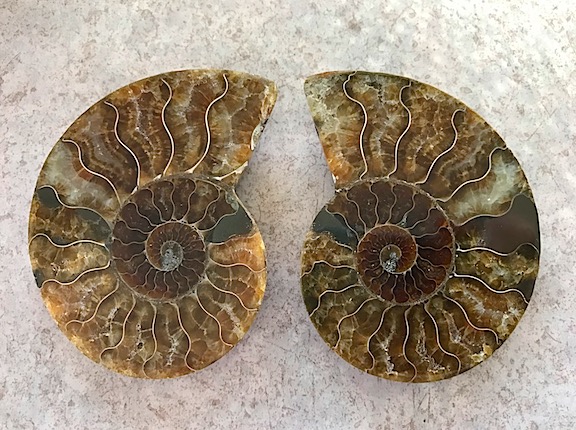Back at the backwaters.
For the second year in a row, I’m camped with some friends in some BLM land south of Ehrenberg, AZ, right along the Colorado River. This year’s site is on the north side of an inlet into some channels that parallel the river on the otherwise dry side of a levee. We’re on a peninsula across the inlet from where we camped for a while last winter. My friends preferred this spot because it gets sunlight earlier in the morning; the other spot is in the shadow of some 200-foot high cliffs to the southeast for too much of the morning. Sunlight is everything in the winter, especially when you’re getting most of your power from solar panels.

A look down at this year’s campsite from the top of the cliffs to the southeast. Our site, which is just about dead center in this shot, consists of my truck camper, Janet’s little pull trailer, Janet’s workshop tent, and our two vehicles. (My truck was with me at the top of the cliffs when I shot this photo.) The “backwaters” is the forked channel on the right side of this image.
The site is somewhat remote: seven miles from pavement. Other than the folks camped out across the inlet and the occasional camper driving in to see if this site is occupied, we’ve got a lot of privacy and solitude. Across the river is an RV park that’s remarkably quiet, although they do have a bunch more lights than I wish they had. The sky is not nearly as dark as I’d like it to be; this is not the place I’ll be doing any astrophotography.
We’ve had guests. My friend Rebecca joined us for two nights at the beginning of my stay and Janet’s husband Steve just joined us today for the rest of our stay. We’ve also had a few visitors: another snowbird named Mike who’s staying with his wife in the first campsite we had last year has come by for brief visits and Janet’s artist friends Karen and Steve who camped with us in our second campsite across the inlet last year came by today to help troubleshoot an electrical issue I was having with my camper. (Turns out I have a bad battery and will get it replaced on Sunday.)
Life is very laid back around here. There is no schedule.
I wake up, usually before dawn, and if I’m lucky — which I usually am — I’ll get a 2-bar LTE signal on my iPad so I can catch up on the latest political craziness on Twitter and check in with friends on Facebook. I very rarely check email.
I’ll roll out of bed around dawn and might be more motivated to do so if we’re having one of our spectacular sunrises. That’s when I’ll go down to the beach in my pajama shirt, sweat pants, and slippers with my phone to try to capture a shot that beats the last best one I took. Janet sometimes gets down there before me and sometimes doesn’t.

I don’t think a sunrise photo will get much better than this. And yeah; I shot this with my iPhone 7.
Then back to my camper to make coffee with the immersion coffee maker someone talked me into buying. (They’re right; it does make the best coffee without electricity.) I’ve got a technique where I boil water in a glass kettle on the stove with my empty coffee cup as a sort of lid. That speeds up the boil while thoroughly heating my cup so my coffee stays hot extra long.
I’ll keep busy by writing up the previous day’s journal entry or a blog post or reading something interesting in the New York Times or Washington Post. Janet usually has her coffee out by the fire pit and if there are still embers from the previous night’s campfire, will get another fire going. Usually there isn’t.

We went fishing this morning. It was supposed to rain, but it turned out to be a beautiful day.
What follows varies from day to day. Janet usually either goes fishing or paints — she’s an artist — and sometimes does both. I usually putter around the RV, neatening it up from the previous day, then try to get some serious writing done — I’m working on a memoir about my first ten years as a helicopter pilot and I’m really procrastinating a bit more than I should be. Sometimes I go fishing with Janet. (Today I actually caught a small bass; although it was large enough to keep, we tossed it back. The fish were literally jumping out of the water.)

Janet shot this photo from our campsite of me and my truck atop the cliff.
The other day I drove to the top of the cliff southeast of our campsite. I wanted some photos for this blog post (see the photo at the top) and I also wanted to see if my truck could make it. (It could.) Last year, I chickened out near the top and walked the rest of the way; this year, I took it all the way to the top. The drive is no easy task in a truck the size of mine; there’s a very steep, narrow gravel “road” to climb followed by a winding pathway that sometimes goes through some very deep sand. It’s all about four-wheel-drive, good tires, momentum, and knowing when it’s safe to stop.

I must have shot 20 images of this blue heron from the driver’s side window of my truck with a 300 mm lens. This one is the best, although I think it might benefit from a touchup in Photoshop.
I’ve done some photography. This is a desert riparian area so there are some water birds. Mostly duck-like birds — I really don’t know exactly what they are — and at least one blue heron and one white heron. The other day I got a bunch of really nice pictures of the heron, no small task because he seems to spook very easily. When he does, he makes one hell of a racket as he takes off into the air, usually landing within a quarter mile for a new hunting spot.
We also go boating. Janet brought a river raft rowboat that can seat both of us comfortably for fishing. I also brought my kayak and have gone paddling with Penny. We do all this in the backwater channel. Sadly, the water level is very low this year — “they” are supposedly working on either canals or docks or possibly both so they’re limiting what comes through the Parker Dam far up river. Last night, for some reason, the water level was very high. But this morning it was low again.
Once in a while we’ll go into town. There are actually three towns:
- Ehrenberg, AZ is Exit 1 on I-10. There’s a truck stop on the south side of the road and a “resort store” on the north side. The resort store is where we buy fishing licenses, refill water bottles, throw away our garbage, and dump RV tanks on the way in or out of our campsites. They also sell Mexican ice cream pops, which are a cheap and amazing treat. And worms for fishing. We go there two or three times a week, usually on our way in or out from somewhere else. It’s about 8 miles from our camp. The post office is also there; that’s where we get our mail forwarded via General Delivery.
- Blythe, CA is a few miles west of the Colorado River off I-10. That’s where we do grocery shopping, usually at Smart and Final, although there is an Albertson’s. There’s also an excellent Ace hardware store, an O’Reilly’s auto supply, a K-Mart, and a Walgreens. Other than that, Blythe is a sad little town and I can’t see any other reason to visit it. (Sorry, Blythe, but I do tend to tell it like it is.) I do know its airport, on the west side of town, very well since that’s where I nearly always stop for fuel for my helicopter when flying along the I-10 corridor between California and Arizona. Smart and Final is about 12 miles from our camp.
- Quartzsite, AZ is Exit 17 on I-10. That’s a hopping place in January, full of rock shows and art shows and RV shows and all kinds of booths to buy all kinds of useful and junky stuff. It’s what brings Janet to this area of Arizona; she displays and sells her artwork at the Tyson Wells show that runs concurrently with the big RV show at the second half of January. (There’s another show going on there now, so Janet has to wait; she waits out on BLM land where camping is free and life is mellow.) I like Quartzsite because it’s weird and I can always find something neat to buy for my truck or my RV or my home. Last week I bought some fossils. This week I bought a little DC water pump I can use to transfer water from my 6-1/2 gallon water jugs to my camper’s water tanks. Next week, I’ll buy new batteries for my camper and possibly an additional solar panel. (Yes, Quartzsite does see a lot of my money; I bought a cool neon sign there last year and my old 5th wheel trailer back in 2010.)
Between Quartzsite and Ehrenberg is the Chevron station with cheap diesel and gas; that’s where Janet and I fuel up if we need to. (We don’t usually because we really don’t go far.)
In the late afternoon, we regroup for dinner. We share cooking duties. Our main goal these days is to empty our refrigerators and freezers. I brought a ton of frozen food from home and we’ve been eating some of that. We had nice little filet mignons the other day. Janet makes various dishes — she made an excellent chicken with quinoa dish the other night and we had pan-fried panko-crusted bass (that she caught, of course) one night last week. I always seem to have ingredients for a salad. I think we’re having pad thai chicken for dinner tonight; Janet has the noodles and chicken and I have the pad thai sauce and other ingredients.

At sunset, if there’s a show I’ll go out and take photos from the levee. I shot this on my second night here. That’s the Colorado River with California on the other side.

We have a campfire every night.
By the time dinner is ready, the sun has gone down. Janet usually has a fire going before it gets dark. We sit in front of the fire and eat, drink wine, and chat. Very relaxing. After dinner, we’ll spend a while longer in front of the fire with our dogs in our laps. Sometimes the sky is full of stars. The nearly full moon rising the other evening was a real show-stopper.

Moonrise from our campsite.
We’ll each turn in to our campers between 8 and 9 PM. Sometimes I’ll write up my journal entry for the day. Other times I’ll just relax in bed with Twitter or a book or a crossword puzzle. Then it’s lights out. If it’s a clear night, I can see the stars through the big sunroof over my bed.
It’s a very simple, very quiet, very mellow existence here. This year, I’ll be at the backwaters for a total of nearly two weeks. It’s quite a change after my month-long stay in a friend’s guest house in Wickenburg.
From here, I go to San Diego with friends. I might spend a night at Glammis Dunes near Yuma, hoping to get some good photo opportunities if the sand isn’t too disturbed by tire tracks after a holiday weekend. On the way back, I’ll visit various hiking spots near Borrego Springs and possibly Joshua Tree National Park. Then I’ll be back at Quartzsite for the RV show. I’ll camp out in the desert near town and make daily trips in to visit the shows and check out the RVs. I’m in the market for a tiny toy hauler; who knows what I might come home with?
And who knows where I’ll go from there? I have another month to kill before my seven-month vacation is officially over — and even then I have the ability to do some travel before I need to be back home with my helicopter in May.
But the Colorado River Backwaters is one of my favorite destinations for off-the-grid camping. I look forward to coming back every year I travel south for the winter.














